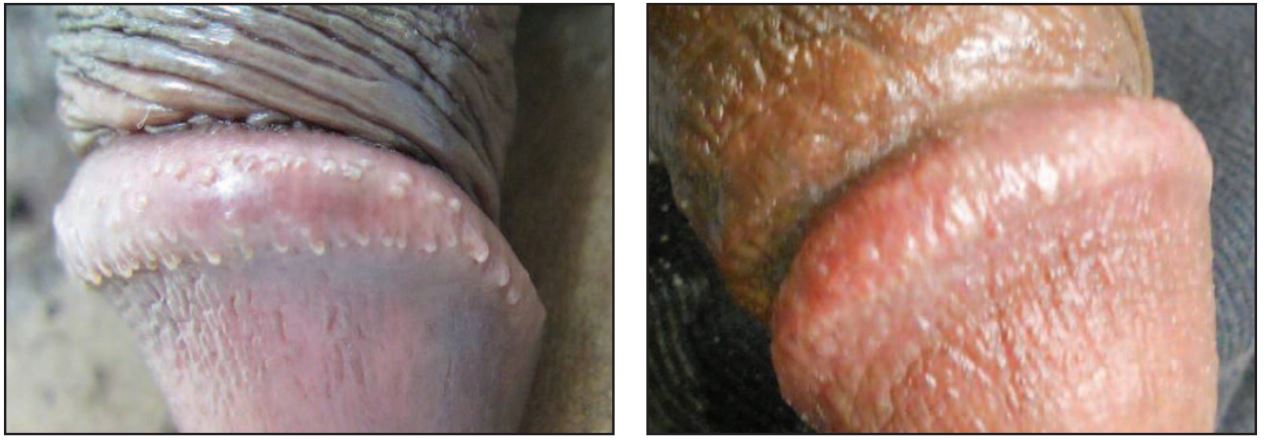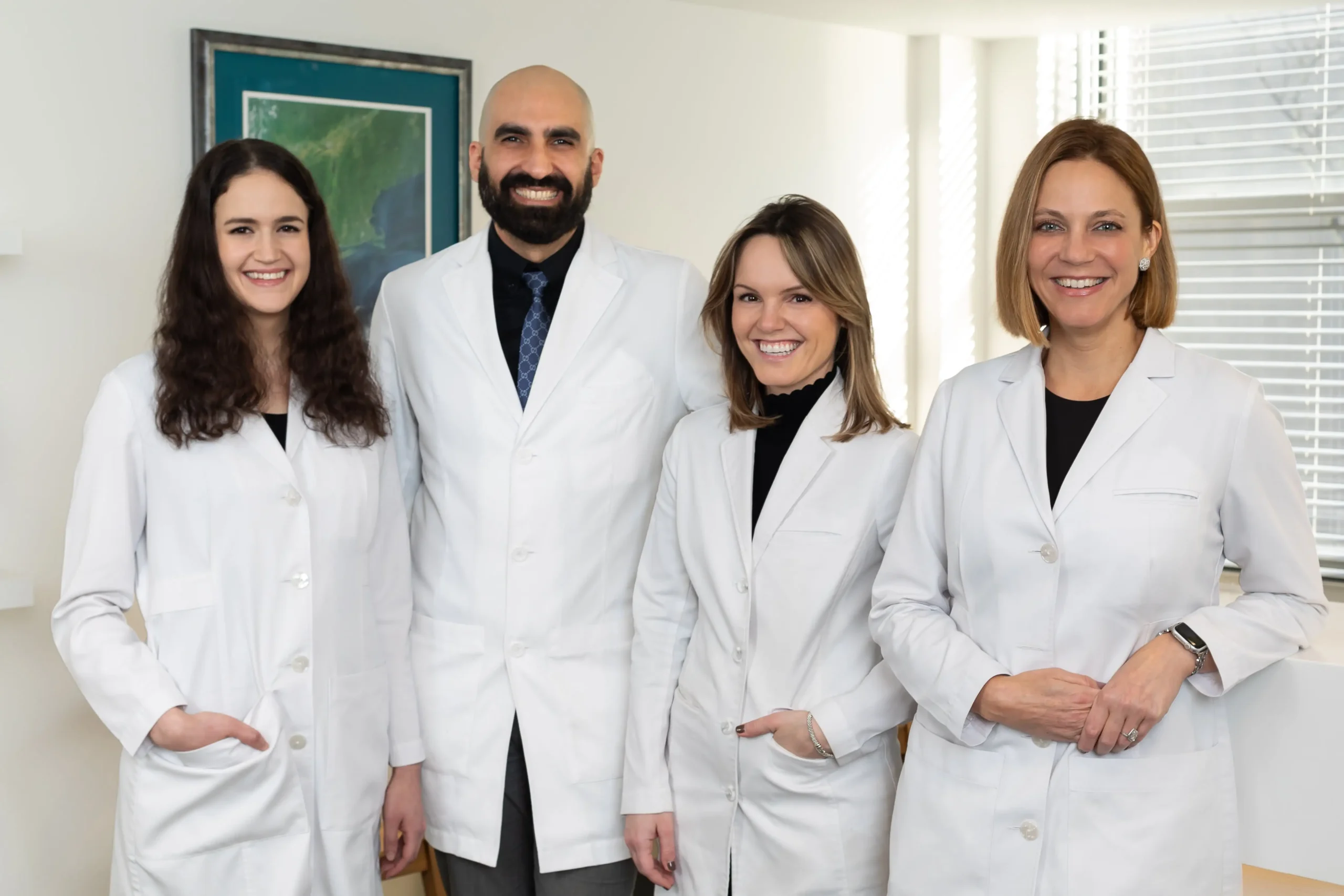Pearly Penile Papules Treatment
Jump To
Conveniently located to serve Boston, MA
What Are Pearly Penile Papules?
Many men out there experience the appearance of small bumps around the base of the tip of their penis (the glans). In fact, as many as 25% of all men will have this condition at some point.
Pearly penile papules are tiny skin-colored or white bumps found on the penis of adult men and most commonly arise when men are in their teens or twenties. The papules have a pearly sheen and may appear yellow in direct light. Technically, these papules are angiofibromas, which are lesions composed of fibrous tissue and blood vessels.
Pearly penile papules are a common, benign skin condition. They are often confused for genital warts, and the appearance of these bumps can cause a great deal of anxiety in patients who mistakenly believe them to be sexually transmitted.
However, pearly penile papules are not a dangerous skin condition and can be treated safely in our office if a patient desires. The Dermatology Institute of Boston is located near the Charles River and the Boston Common, in Downtown Boston adjacent to Copley Square and the Back Bay train station. To arrange your PPP consultation, contact us online or call us at (857) 317-2057.
What Causes These Small Bumps?
It is not known why pearly penile papules develop, but they are more commonly seen in uncircumcised men. Unlike genital warts and herpes, the bumps are not caused by a virus. Pearly penile papules are not painful, do not transform into cancer, and are not contagious.
PPP often run in families, meaning there may be a hereditary aspect to the condition. Although we don’t know the exact cause, it has been hypothesized they may be related to hormone levels, since they frequently form during puberty.
Most men notice that pearly penile papules become less noticeable as they age. However, despite their benign state, many men wish to get rid of these bumps.
Why Should I Get Treatment for Pearly Penile Papules?
Seeking pearly penile papules treatment is a personal choice. The condition is completely benign, meaning it will not lead to cancer or cause health problems. However, many men still choose to see a pearly penile papules doctor.
Why? The answer usually comes down to appearance. Pearly penile papules can have a negative psychological impact on men. They may worry that sexual partners will mistake the papules for a sexually transmitted infection, or they may simply dislike the appearance of the bumps.
Why Choose Us for Pearly Penile Papules Treatment?
The acclaimed board-certified dermatologists at the Dermatology Institute of Boston have safely and effectively removed pearly penile papules on many patients. The founder of The Boston Institute of Dermatology, Dr. Emmy Graber, has also written medical journal articles about her experience treating pearly penile papules.
Our dermatologists specialize in cosmetic dermatology and frequently share their medical knowledge on NPR and in national publications. Castle Connolly honored members of our team as Top Doctors in 2024, which also includes recognition as a 2024 Boston Top Doc.
Along with being a renowned dermatologist, Dr. Graber serves as an Affiliate Clinical Associate Professor at Northeastern University and has previously been Director of the Boston University Cosmetic and Laser Center.
Thanks to our staff’s high standard of patient care, The Boston Institute of Dermatology has been named a top dermatology practice for patients in and near Boston. For patients coming to us for pearly penile papules, our practice is at the corner of Dartmouth St. and Stuart St. We’re not far from quality hotels like the Sheraton Boston Hotel, the Fairmont Copley Hotel, the Boston Marriott, and Raffles Hotel.
Many PPP patients take a trip to the Public Garden before coming to our office. America’s first public botanical garden, the Public Garden was established in 1837. It’s a great place to visit for scenic fountains, beautiful flowers, and swan boat rides.
Diagnosing Pearly Penile Papules
To diagnose your pearly penile papules, it will be necessary to come in for a consultation with one of the dermatologists at The Dermatology Institute of Boston. During this consultation, your dermatologist will perform a physical examination and ask questions about when the papules first developed.
Your dermatologist may use a dermoscope for a closer look at the papules. This device offers a magnified view of the lesions. You may potentially need a biopsy, but this is very rare for PPP.
Treatment Options For Pearly Penile Papules
Typically, the first step in pearly penile papule treatment is making certain the condition is identified correctly and that the symptoms are not actually a sexually transmitted infection. A dermatologist can help with this identification.
Unfortunately, pearly penile papules treatment cannot be performed at home. There are no creams or pills that can effectively reduce or eliminate pearly penile papules. Refrain from picking at the papules or breaking the skin as these actions may put you at risk for infection. Over-the-counter wart removers and home remedies or natural remedies are not helpful and may damage the penis.
However, treatment of pearly penile papules can be performed by a dermatologist if desired by the patient. Our dermatologists tend to prefer a quick, precise, and effective procedure called electrocautery. This procedure can be easily performed in our office, located just blocks from the Mass Pike (Interstate 90). We’re near the Boston Public Library, and we’re only a 10-minute drive from the Museum of Fine Arts, Boston.
Electrocautery Treatment for Pearly Penile Papules
Also called electrodessication or electrosurgery, electrocautery is a relatively quick treatment, usually taking less than ten minutes. For most patients, more than one treatment is suggested.
Treatments can be done with little to no pain or discomfort. First, a topical anesthetic is applied to the region. Low-voltage electricity is then applied to a probe, increasing its temperature.
The heated probe is held against the papule, destroying the tissue. Only the papule is affected, and the surrounding tissue remains uninjured and safe. The process cauterizes the area where the papule connects to the penis, greatly reducing the chance of bleeding.
Before and After Treatment

The cauterizing process encourages quick healing. Downtime is minimal, and most patients can return to work the day after electrocautery treatment. Side effects like mild redness, swelling, or discomfort disappear in around a week.
While the area is healing from the PPP treatment, avoid sexual activity. Anything that causes friction can exacerbate post-treatment side-effects like swelling and redness.
Electrodessication’s results are typically permanent, and the chance of new papules growing is extremely low.
Arrange Your Consultation
Schedule a consultation with one of our board certified dermatologists to discuss which treatment method is best for reducing pearly penile papules. Call us at (857) 317-2057 or contact us online to arrange your personalized consultation. We’re close to restaurants like La Padrona, Oak Long Bar, and Sorellina. For PPP patients coming to us on the train, we’re only one block from Back Bay Station and Green Line MBTA stops.
Pearly Penile Papules FAQ
How do I tell the difference between HPV and PPP?
The best way to tell the difference between HPV and PPP is visiting an experienced dermatologist. They will be able to examine the bumps and perform an STI test if necessary.
HPV (human papillomavirus) warts and pearly penile papules have a lot of similarities, which can make it difficult to tell them apart. For both, tiny bumps can appear on the penis. These bumps may be the color of the surrounding skin and may be small and dome-shaped.
One key difference between the two is the location of the bumps. HPV warts may form anywhere on the penis and groin areas whereas pearly penile papules form around the head of the penis in rows. Additionally, if you’re experiencing bumps around your anus or perineum, these may be HPV warts, which may be an indicator that your penile bumps are also HPV warts.
PPP are always dome-shaped and are usually one to four millimeters in height and one to two millimeters in diameter. Genital warts come in a range of sizes and shapes. PPP are yellow, white, or pink, whereas genital warts are sometimes darker.
Topical treatments or cryotherapy can often be used to treat HPV warts. PPP can only be removed using a procedure, and they will not go away on their own or with the use of topical treatments.
HPV warts form as a result of sexual contact and are viral in nature, whereas PPP are not caused by sexual contact and are not viral.
How should I prepare for PPP treatment?
To prepare for your PPP treatment at The Dermatology Institute of Boston, you’ll first need to come in for a consultation. At your consultation, make sure to tell your dermatologist about all current medications and supplements and all medical conditions.
There is very little that you need to do to prepare for PPP treatment but wearing comfortable clothing is recommended.
Does PPP removal hurt?
PPP removal does not hurt, provided it is performed by an experienced professional dermatologist. At The Dermatology Institute of Boston, our providers have the years of experience needed to perform safe and pain-free removal of pearly penile papules.
Electrocautery involves little to no pain, since our dermatologists apply a topical numbing cream beforehand. There may be a minor degree of soreness afterwards, but this will fade.
How long do PPP bumps last?
Generally, PPP bumps can last for a person’s entire life. They may become smaller and less prominent as a person ages. Generally, however, they are permanent unless the proper treatment is performed.
Are pearly penile papules dangerous?
Pearly penile papules are not dangerous. They are completely safe and harmless. They are non-transmissable and are not the result of poor hygiene or STIs.









